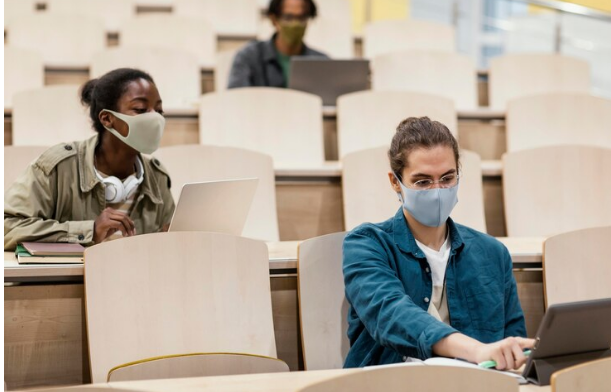How Universities Are Adapting to the Post-Pandemic World
The COVID-19 pandemic disrupted life as we knew it, and education was no exception. Universities worldwide had to shift gears quickly, moving classes online, changing their methods of engagement, and finding innovative ways to ensure students could continue learning. Now, in the aftermath of the pandemic, universities are adapting to a new normal, making changes that could redefine higher education for years to come.
In this post, we’ll explore how universities are navigating the post-pandemic landscape, implementing new technologies, transforming teaching models, and preparing students for a changing world.
1. The Rise of Hybrid and Online Learning
One of the most significant changes to come out of the pandemic is the widespread adoption of hybrid and online learning. Prior to 2020, most universities offered traditional in-person classes, with online courses seen as a niche offering. However, the rapid shift to online learning during the pandemic has forced universities to rethink how they deliver education.
Many institutions are now embracing hybrid models, which combine both online and in-person learning. This offers students greater flexibility, allowing them to access course material from anywhere while still benefiting from face-to-face interactions with professors and peers when needed.
Why This Matters:
- Flexibility for Students: Hybrid models cater to different learning styles and life situations, making education more accessible to students who may have work or family obligations.
- Enhanced Learning Tools: Universities are investing in online platforms, virtual classrooms, and learning management systems (LMS) to support this new way of learning.
- Global Reach: With online components, universities can attract international students who might not have been able to relocate, thus expanding their reach.
- Universities are now blending the best of both worlds—traditional and digital—to create a more inclusive and adaptable learning environment.
2. Technology Integration in the Classroom
The pandemic accelerated the adoption of education technology (EdTech), and many universities are continuing to integrate these tools into their curricula. From AI-powered tutoring systems to virtual reality labs, technology is enhancing the learning experience in ways that were unimaginable just a few years ago.
For example, artificial intelligence (AI) is being used to provide personalized learning experiences for students. AI tools can analyze student performance data and recommend resources or alternative learning pathways to help students succeed. Similarly, virtual and augmented reality (VR/AR) are being used in fields like science and engineering to create immersive, hands-on learning experiences.
Why This Matters:
- Personalized Learning: AI and data analytics allow for more customized learning experiences, catering to individual student needs.
- Hands-On Learning from Anywhere: VR and AR allow students to conduct experiments or participate in simulations from the comfort of their homes.
- Data-Driven Decision Making: Universities are using data analytics to improve course offerings and student outcomes, making education more efficient and effective.
- The continued integration of cutting-edge technology in higher education will undoubtedly shape the future of how students learn and interact with content.
3. Mental Health Support for Students
The pandemic highlighted the importance of mental health, particularly for students who were suddenly isolated from their peers and support systems. As universities adapt to the post-pandemic world, there is a stronger emphasis on mental health support.
Many institutions have expanded their mental health services, offering virtual counseling, mental wellness apps, and peer support networks. Universities are also incorporating mental health education into their curriculums, teaching students how to manage stress, anxiety, and other mental health challenges.
Why This Matters:
- Increased Awareness: Mental health is no longer a secondary concern but a core part of student well-being.
- Accessible Support: Virtual counseling services allow students to access help from anywhere, making mental health resources more accessible than ever before.
- Holistic Education: By promoting mental health alongside academic performance, universities are fostering a healthier, more balanced student experience.
- The pandemic has shown that universities must prioritize student well-being, and mental health services are now an integral part of the higher education ecosystem.
4. Rethinking Campus Spaces and Social Distancing Measures
As universities return to in-person learning, many are rethinking their campus spaces to accommodate new health and safety protocols. While the most stringent social distancing measures may no longer be in place, universities are still being cautious and adapting their campuses to be safer for students, faculty, and staff.
For example, many institutions have redesigned classrooms to allow for flexible seating arrangements that can be adjusted for smaller or larger groups. Common areas like libraries, cafeterias, and study lounges are also being modified to ensure proper ventilation and hygiene standards.
Why This Matters:
- Health and Safety: Universities are adopting long-term safety measures to ensure that students can return to campus with confidence.
- Blended Spaces: Universities are creating multi-purpose spaces that support both in-person and remote learners, allowing for greater adaptability.
- Future-Proofing Campuses: Many of these changes are being designed with future health crises in mind, ensuring that campuses remain resilient in the face of new challenges.
- The pandemic has forced universities to rethink their physical spaces, leading to more flexible, future-proof campuses that are better suited to a changing world.
5. Shift Towards Interdisciplinary Learning
As the world becomes more interconnected, universities are placing a greater emphasis on interdisciplinary learning. The pandemic highlighted the need for solutions that cross traditional boundaries, such as how public health intersects with economics, technology, and politics. Universities are now encouraging students to think beyond their specific fields of study and develop skills that are applicable across multiple disciplines.
For example, many universities are offering joint degree programs or interdisciplinary courses that allow students to combine subjects like computer science and biology or business and environmental science. This prepares students to tackle complex, real-world problems that require a multi-faceted approach.
Why This Matters:
- Holistic Problem Solving: Interdisciplinary learning encourages students to approach problems from different angles, fostering creativity and innovation.
- Broader Skill Sets: Graduates with experience in multiple disciplines are better equipped to navigate the complexities of the modern workforce.
- Adaptability: The ability to draw from different fields makes students more adaptable, which is crucial in a rapidly changing job market.
- By fostering interdisciplinary collaboration, universities are preparing students to solve the world’s most pressing challenges in a more holistic and effective way.
6. Supporting Lifelong Learning and Upskilling
The pandemic caused massive disruptions in the workforce, with many industries accelerating their adoption of digital tools and automation. This has increased the demand for lifelong learning and upskilling, as workers seek to stay relevant in an evolving job market. Universities are adapting by offering more flexible learning options, such as short courses, online certifications, and stackable credentials that allow professionals to continue learning throughout their careers.
Universities are also partnering with industries to design programs that meet the specific needs of employers, ensuring that students are gaining the skills that will be in demand in the future.
Why This Matters:
- Career Advancement: Lifelong learning opportunities allow professionals to continuously upskill, keeping them competitive in the job market.
- Industry Collaboration: By working closely with employers, universities can ensure that their programs are aligned with the needs of the workforce.
- Accessibility: Online courses and certifications make it easier for working professionals to continue their education without having to commit to full-time study.
- The shift toward lifelong learning is not just a trend but a necessity in today’s fast-paced world, and universities are leading the way by offering more flexible and accessible education options.
7.Strengthening Sustainability and Social Impact Initiatives
The pandemic has also sparked a renewed focus on sustainability and social responsibility. Universities are incorporating these themes into their curricula, research initiatives, and campus operations. Many institutions are greening their campuses, reducing their carbon footprints, and teaching students about the importance of sustainability in various fields of study.
Additionally, universities are placing a greater emphasis on social responsibility, encouraging students to become global citizens who are aware of the impact of their actions on the world. This includes promoting diversity, equity, and inclusion (DEI) initiatives and offering courses that address topics like climate change, social justice, and public health.
Why This Matters:
- Educating Future Leaders: Universities are preparing students to become leaders in the fight for sustainability and social equity.
- Institutional Responsibility: By adopting sustainable practices, universities are setting an example for students and the broader community.
- Global Impact: Teaching students about sustainability and social responsibility ensures that they will carry these values into their future careers.
- As the world grapples with complex issues like climate change and inequality, universities are stepping up to prepare students for a more sustainable and socially responsible future.
Conclusion: The Future of Universities in a Post-Pandemic World
The COVID-19 Pandemic: A Catalyst for Higher Education Transformation. From the rise of hybrid learning to the increased focus on mental health and sustainability, universities are adapting in ways that will shape the future of education for years to come. By embracing new technologies, rethinking campus spaces, and promoting interdisciplinary learning, universities are not just surviving the challenges of the post-pandemic world—they are thriving.
The changes happening today are paving the way for a more flexible,



%20Austria%20PhD%20Scholarship%202025.png)





0 Comments